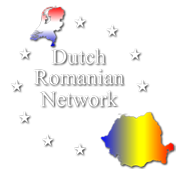Newsletter December/January 2023

Let everything that breathes exist in peace…!
That’s how singer Rob de Nijs sounded during his emotional farewell concert, alluding to the war in Ukraine. We trust that people are going to discover that being right is more attractive than being right.
Above all, we as DRN wish you all a healthy 2023.
Above all, we wish the politicians much wisdom and a reduction of personal and party interests. We would like to remind the media of the statement by top economist Peter Hein van Mulligen of the Central Bureau of Statistics (CBR) that we should not talk each other into a crisis.
We are confident that we will soon be able to welcome our Romanian friends to Schengen. Let’s become more side by side instead of opposite each other!So we dare you to join us in the challenge to make something of it in 2023!
Energy sector
Romania is founder of historic agreement between Azerbaijan, Romania, Georgia and Hungary
The present strategic agreement is a Romanian initiative that is thus crowned and will thus make a positive contribution to Europe’s energy supply, i.e. greater independence from the Russian Federation.
The agreement between the governments of the Republic of Azerbaijan, Georgia, Romania and Hungary on the strategic partnership in the field of green energy development and transportation was signed Saturday at the Cotroceni Palace, in the presence of European Commission President Ursula von der Leyen and President Klaus Iohannis. The agreement was signed by President of the Republic of Azerbaijan Ilham Aliyev, Prime Minister of Georgia Irakli Garibashvili, Prime Minister of Romania Nicolae Ciucă and Prime Minister of Hungary Viktor Orban.
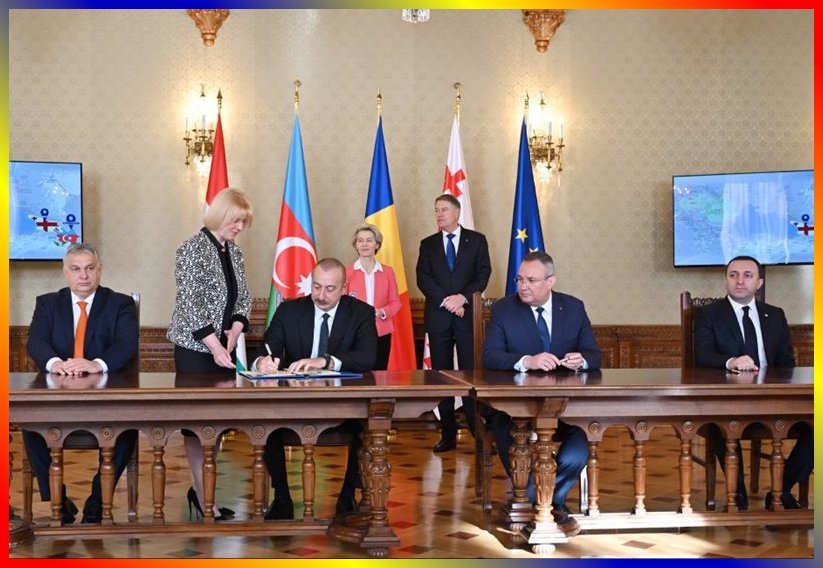
The agreement will provide the financial and technical framework for the realization of the project of the undersea cable for the transmission of electricity from renewable sources between Romania and Azerbaijan, through Georgia and the Black Sea, and then for the transportation of this energy to Hungary and the rest of Europe, through the European transmission system.
The submarine electricity transmission cable project through the Black Sea is part of the energy agreements agreed between the EU, represented by the EC, and Azerbaijan, and is also a flagship project for Georgia, as part of the EU Global Gateway strategy.
The agreement between the governments of Azerbaijan, Georgia, Romania and Hungary on the Strategic Partnership in energy development and transportation will link the two shores of the Black Sea and can transmit electricity to Moldova, the Western Balkans and Ukraine, European Commission President Ursula von der Leyen said Saturday in Bucharest.
“Since the beginning of the Russian war, we decided to give up fossil fuels of Russian origin and diversify our options to reliable partners in the field of energy, such as those at this table. And it’s working. The European Union was able to offset the gas cuts from Russia. But we’re not just talking about managing a new geopolitical situation. It is about creating a future for us in terms of clean, accessible and secure energy sources, and these are the forms of renewable energy,” Ursula von der Leyen said.She went on to say that “this project will connect the two shores of the Black Sea and further to the Caspian Sea region, both in terms of digital communications and energy.”
“The power cable under the Black Sea offers several opportunities. This project could bring significant benefits to Georgia, a country with a European destination. It could turn the country into an electricity hub and integrate it into the EU electricity market. The cable under the Black Sea could transport electricity to our neighbors in Moldova and the Western Balkans and, of course, to Ukraine. It will help rebuild Ukraine’s energy system and rebuild the country,” Ursula von der Leyen stressed. She concluded that, in this context, “we can say that both sides of the Black Sea have never been so close.”
President Klaus Iohannis also stated that “given the current security context due to the military aggression against Ukraine, we need better cooperation and solidarity to address the current obstacles.”
“This agreement provides a framework for long-term cooperation between our countries in a number of very important areas, first energy production, transport and trade, then the development of new infrastructure, including a submarine cable through the Black Sea, then green hydrogen projects and then efficiency. This is an ambitious agreement that shows that together we can make a serious contribution to strengthening European energy security and will contribute to a sustainable increase in cooperation in the region,” the head of state said at the Cotroceni Palace.He stressed the importance of green energy.
“The current situation affects us all. The security environment and economic difficulties require more interconnections, more cooperation at the regional and global level. Our energy cooperation (…) will increase our energy adaptability, but also the number and quality of transportation routes. The potential of green energy in the Caspian region, especially in Azerbaijan, is great. It is necessary to think in the future and take the initiative on this issue in our region,” the head of state said.
President Iohannis said the next phase is the Black Sea submarine cable. “We also want to increase the sea transport connections from Constanta to Georgia. These efforts will also increase connectivity to Azerbaijan and further to Central Asia,” he added.
President of the Republic of Azerbaijan Ilham Aliyev said Saturday that his country will become a major supplier of electricity to Europe, especially green energy.
“This agreement is a step to create a corridor for green energy. (…) Azerbaijan is expanding its geographical area of action by supplying gas to European markets. It is a win-win situation because Europe needs to strengthen its energy security, and Azerbaijan needs markets for its vast resources. Today we start building a new “bridge” from Azerbaijan to Europe. Our country will become an important supplier of electricity to Europe, especially green energy,” said the President of the Republic of Azerbaijan.
He also revealed that his country exported 8.2 billion cubic meters of gas to the EU last year and 11.3 billion cubic meters of gas this year.
“Next year there will be at least 11.6 billion cubic meters of gas,” Ilham Aliyev informed, recalling Romgaz’s signing of an agreement to supply gas from Azerbaijan to Romania starting in January.
The quadrilateral intergovernmental agreement will provide the financial and technical framework for the realization of the project of the submarine cable for the transmission of electricity from renewable sources between Romania and Azerbaijan, through Georgia and the Black Sea, and then for the transmission of this energy to Hungary and the rest of Europe, through the European transmission system
The project of the undersea electricity transmission cable through the Black Sea is part of the agreements in the field of energy agreed between the European Union, represented by the European Commission, and the Republic of Azerbaijan, as it is at the same time a flagship project for Georgia, as part of the EU Global Gateway strategy.
Premier Nicolae Ciucă said Saturday that the agreement between the governments of Azerbaijan, Georgia, Romania and Hungary on the strategic partnership in green energy development and transportation “responds to an urgent need to increase the share of green energy and energy security,” demonstrating our country’s determination to invest in energy production and energy infrastructure.
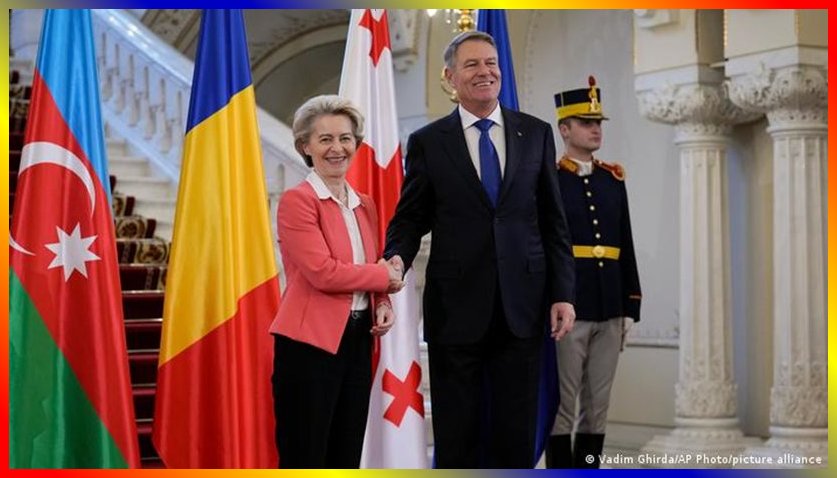
“The agreement responds to an urgent need to increase the share of green energy and energy security. The presence of the EC President underlines the strategic importance of the agreement from the EU perspective. In times of crisis, we must remain united, bring together our potential and resources. Romania is committed to investing in energy production and energy infrastructure and working with our partners to promote energy security for us and the entire region. As a result, Romania will play an important role as a transit country and an energy hub, offering alternatives to our neighbors and partners in the EU, as well as to the Republic of Moldova and Ukraine. The agreement is a step forward toward strengthening long-term bilateral energy cooperation,” the prime minister said at the Cotroceni Palace.
He said the signing of this document is an “important milestone in the EU’s efforts to increase the share of green energy in the fight against global warming and strengthen its ability to cope in this area. “We can thus better meet the challenges we all face in the energy crisis, exacerbated by Russia’s unprovoked war in Ukraine, the effects of the pandemic and inflation. The energy market has high prices and is currently volatile all over the world,” the prime minister said.
Nicolae Ciucă appreciated the progress on fuel transport from Azerbaijan to Romania in 2023. “Thus, we will have additional security in this matter,” the prime minister added.
A project that was also wanted by our neighbors
“In addition to expanding the southern gas corridor, we will also develop a green energy corridor connecting Azerbaijan to Europe. ‘There are two effective ways to realize this initiative: through Azerbaijan’s mainland Zangazur and Nakhichevan corridor from Azerbaijan to Turkey and Europe, and also through the Black Sea submarine cable through Georgia, Romania and Hungary,’ said Minister Elnur Sultanov deputy of Energy of Azerbaijan.
Azerbaijanis say they have great potential for generating renewable energy. The undersea transmission cable under the Black Sea, an older idea from Romania, but which wanted to connect only with Turkey, is now designed to cross the Black Sea from the east, from Georgia, to the west, in Romania. A total of 1,195 kilometers (including 1,100 km underwater) at a capacity of 1,000 MW, including digital connection for communication.
In August, Georgian energy system operator GSE confirmed “active cooperation” with its Romanian counterpart, Transelectrica, and “relevant ministries from Romania, Armenia and Azerbaijan.”
Immediately, the project aroused the interest of Hungary. “Hungary will participate in a large-scale project to transport green power from Azerbaijan to the country and the European market (…) Azerbaijan has significant untapped potential for renewable energy (…) We have agreed that Hungary will join this far-reaching plan, because the project can only receive EU support if there is participation from at least two EU member states. This way, green power can be transported into our country and we can use it and further transport it to the European market,” Hungarian Foreign Minister Péter Szijjártó said in August.
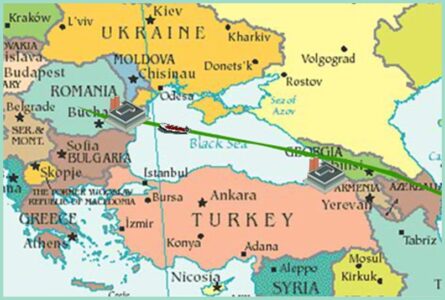 In addition, Serbia, a traditional ally of Russia in Europe and a country where the energy industry is practically controlled by Gazprom, is also asking for the project. “We are working on creating an interconnection between Serbia and Bulgaria, to get significant amounts from our friends in Baku. We have also raised the transportation of electricity and will discuss connections with European partners, as it involves a cable through the Black Sea that would ensure our energy security,” Serbian President Aleksandar Vucic said after a meeting in Belgrade with his Azerbaijani counterpart Ilham Alyev last month. With Hungary’s participation and Croatia’s withdrawal, he sees it as bleak that a previously planned connection to Russia’s Druzhba pipeline is no longer realistic. It looks like the pro-European countries are pulling the strings through the Romanian initiative, and this Southern European unity is increasingly pushing back dependence on Russia.
In addition, Serbia, a traditional ally of Russia in Europe and a country where the energy industry is practically controlled by Gazprom, is also asking for the project. “We are working on creating an interconnection between Serbia and Bulgaria, to get significant amounts from our friends in Baku. We have also raised the transportation of electricity and will discuss connections with European partners, as it involves a cable through the Black Sea that would ensure our energy security,” Serbian President Aleksandar Vucic said after a meeting in Belgrade with his Azerbaijani counterpart Ilham Alyev last month. With Hungary’s participation and Croatia’s withdrawal, he sees it as bleak that a previously planned connection to Russia’s Druzhba pipeline is no longer realistic. It looks like the pro-European countries are pulling the strings through the Romanian initiative, and this Southern European unity is increasingly pushing back dependence on Russia.
DRN Comment: The fact that Hungary has approved the construction of two new nuclear reactors by Russia’s Rosatom in the field of energy supply went unmentioned. The job involves an investment of 12.5 billion euros. Construction will begin in the coming weeks as regulatory agencies in Hungary finally agree after numerous delays.
The war in Ukraine has not diminished Hungarian interest in the project. The intention is to add to the existing nuclear capacity in the country, which already has four reactors. That the Hungarians are engaging with the Russians also shows that ties between Budapest and Moscow, and Hungarian Prime Minister Viktor Orban and Russian President Vladimir Putin, remain close.
Russia is financing most of the project with a €10 billion loan to Hungary, which is itself providing the remaining €2.5 billion. Earlier, Finland, also an EU member state, canceled another similar Russian nuclear power plant project in response to Russia’s invasion of Ukraine. Hungary has always opposed Europe’s attempts to isolate Russia and impose sanctions. Unlike other EU countries, Hungary has also negotiated to receive more gas from Russia, while other countries want to get rid of Russian gas dependence. It also means a certain distance from Turkish influence.
Romgaz and Socar signed the first individual contract to supply Azerbaijani natural gas to Romania
In addition to the four-country green energy contract, ROMGAZ and SOCAR signed the first individual contract to supply Azerbaijani natural gas to Romania, according to a ROMGAZ press release.
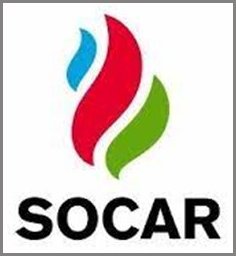 The individual contract allows for scheduled deliveries of natural gas beginning Jan. 1, 2023 through the southern corridor, using the transportation capacity of
The individual contract allows for scheduled deliveries of natural gas beginning Jan. 1, 2023 through the southern corridor, using the transportation capacity of
the TAP and IGB pipelines and the transportation systems of Bulgaria and Romania. The contract is based on a framework agreement the two companies recently signed for an indefinite period.
The signing of this contract ensures the possibility of accessing certain quantities of Azerbaijani natural gas to cover potential consumption needs with imported natural gas. The contract thus serves the strategic goals of security in natural gas supply and diversification of sources.
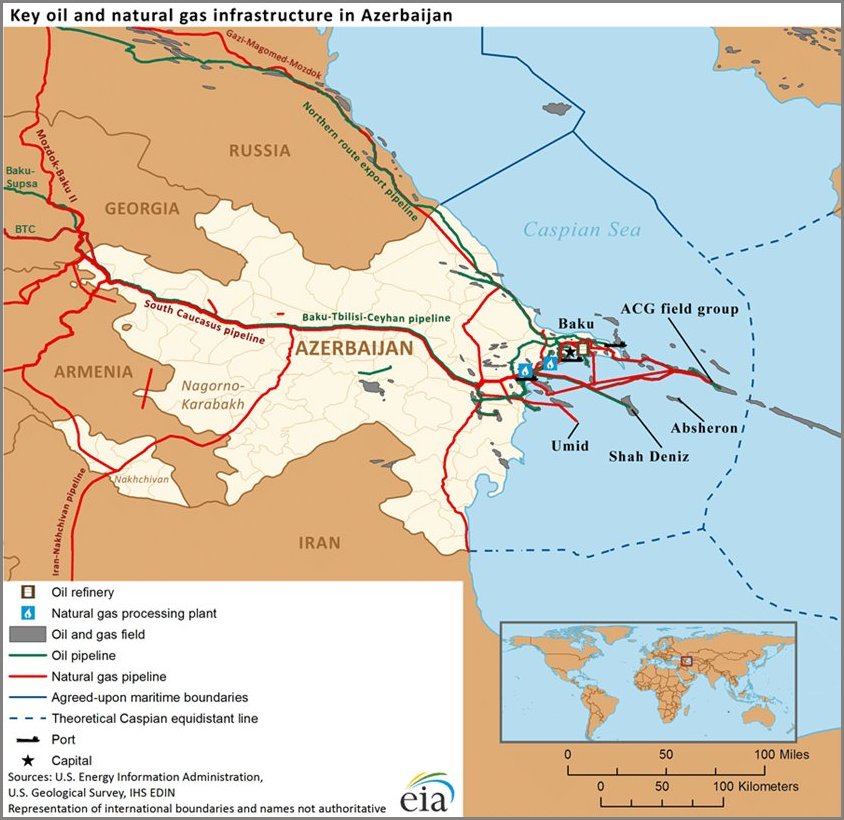
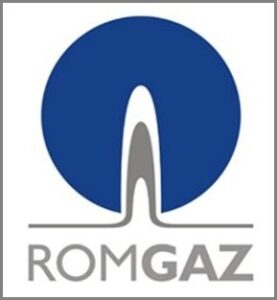 The framework agreement for the supply of Azerbaijani natural gas and this first individual contract is the result of excellent cooperation between SNGN ROMGAZ SA and the company SOCAR, a cooperation that began early this year and was formalized by the signing of a memorandum of understanding in June.
The framework agreement for the supply of Azerbaijani natural gas and this first individual contract is the result of excellent cooperation between SNGN ROMGAZ SA and the company SOCAR, a cooperation that began early this year and was formalized by the signing of a memorandum of understanding in June.
The parties propose to continue cooperation relations and improve delivery mechanisms of Azerbaijani natural gas in the Romanian market. Since Romania has its own gas and oil resources, this ensures energy independence
European Union natural gas consumption fell 20% from August to November. Romania, fifth in savings, with about 35%
The European Union’s natural gas consumption fell by 20.1% in the August-November period – compared to the average of the last five years in this period – representing more than the EU target of 15%, Eurostat announced recently. The mild autumn and consumers’ savings efforts, reports AFP.
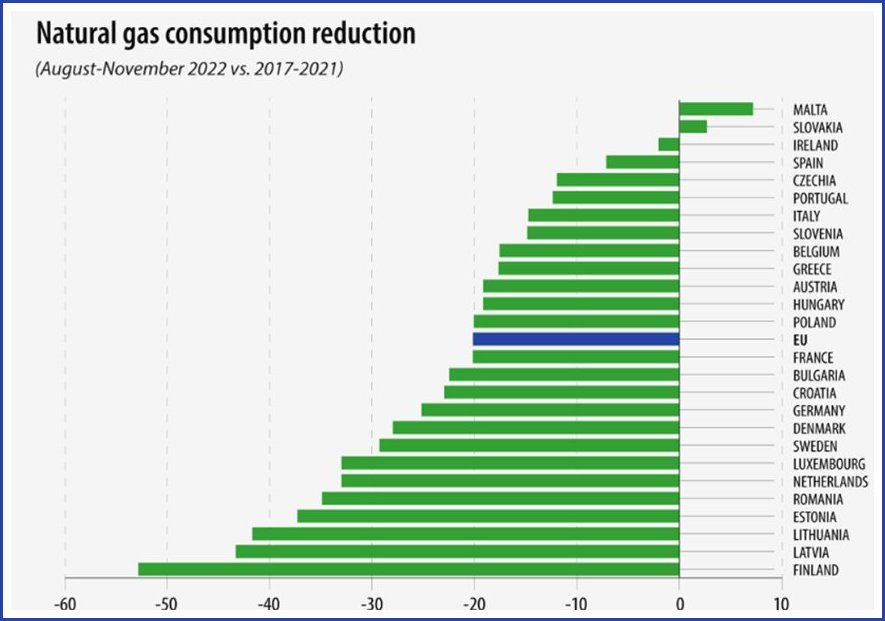
Following drastic cuts in Russian natural gas supplies due to Russia’s war in Ukraine, the 27 agreed in late July to voluntarily reduce their natural gas consumption from Aug. 1, 2022, to Aug. 31, 2023.
They then set a goal of a 15% reduction from the average consumption of the last five years through “voluntary reduction measures” of natural gas consumption. From August to November 2022, consumption fell “in most member states,” the European Statistical Office said in a statement.
Eurostat provides no analysis of the reasons for this decline, which could be explained in part by a particularly mild autumn in Europe, by extra effort on the part of consumers or by a drop in production in certain industries.
In 18 EU member states, consumption fell more than the target, in some cases very markedly.
For example, natural gas consumption fell 52.7% in Finland, 43.2% in Latvia and 41.6% in Lithuania.
Romania (about 35%) ranks fifth, behind Estonia.
Six other EU member states managed to reduce their consumption, but without reaching the target.This is the case of Spain, Italy and Portugal.
Two other EU member states – Malta (+7.1%) and Slovakia (+2.6%) – increased their natural gas consumption. The decline in France is in the EU average.
Eurostat points out that since January, natural gas consumption in the EU has been consistently below the average of the last five years.
Europe, at the world top in energy produced by wind and sun. What is the production in Romania?
Last year, 10% of all energy production worldwide came from wind and solar projects, with the world leaders from this point of view being Denmark, where the share of green energy, just from the two aforementioned sources, is 52% and Uruguay, with 46.7%. How well does Romania rank in these world rankings?
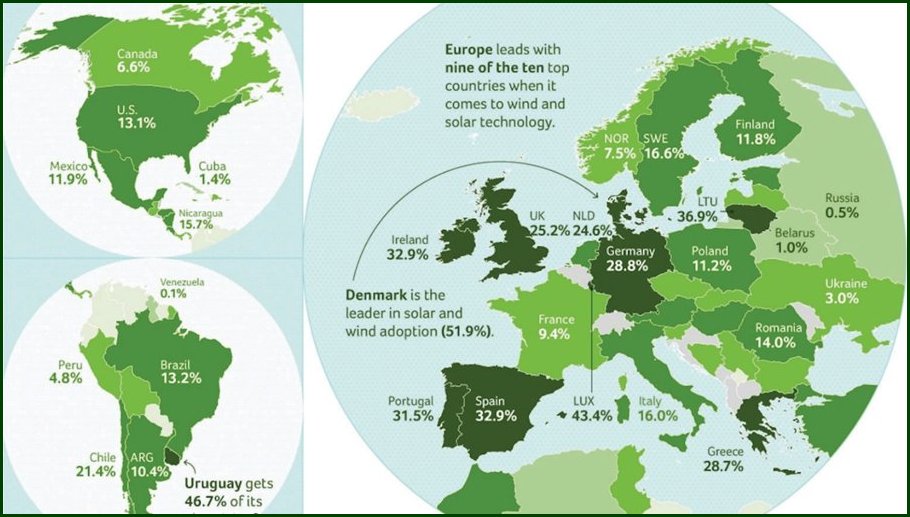 With 14% in wind and solar energy production, Romania, although one of the greenest economies in the world, is a long way from the leaders of the ranking, Denmark, Uruguay and a number of Western European countries. Romania’s economy is greener than that of France, Poland or Norway if only the energy produced by wind and solar projects is taken into account, shows the information platform BigThink, referring to a study conducted by Ember consultants.
With 14% in wind and solar energy production, Romania, although one of the greenest economies in the world, is a long way from the leaders of the ranking, Denmark, Uruguay and a number of Western European countries. Romania’s economy is greener than that of France, Poland or Norway if only the energy produced by wind and solar projects is taken into account, shows the information platform BigThink, referring to a study conducted by Ember consultants.
Sector Climate
Romania among top three EU countries with lowest CO2 emissions
With emissions of 5.7 tons of greenhouse gases per capita by 2020, Romania is one of the least polluting European countries, but at the expense of reduced energy-producing capacities. Romania’s per capita emissions were similar to Portugal’s, with only Sweden and Latvia polluting less. Romania’s greenhouse gas emissions in 2020 were 47% lower than in 1990, when the country emitted 10.8 tons per capita each year. The achievement comes after 30 years in which the country moved away from an industry-heavy communist economy. Romania stands out from the other major Eastern European country, Poland.
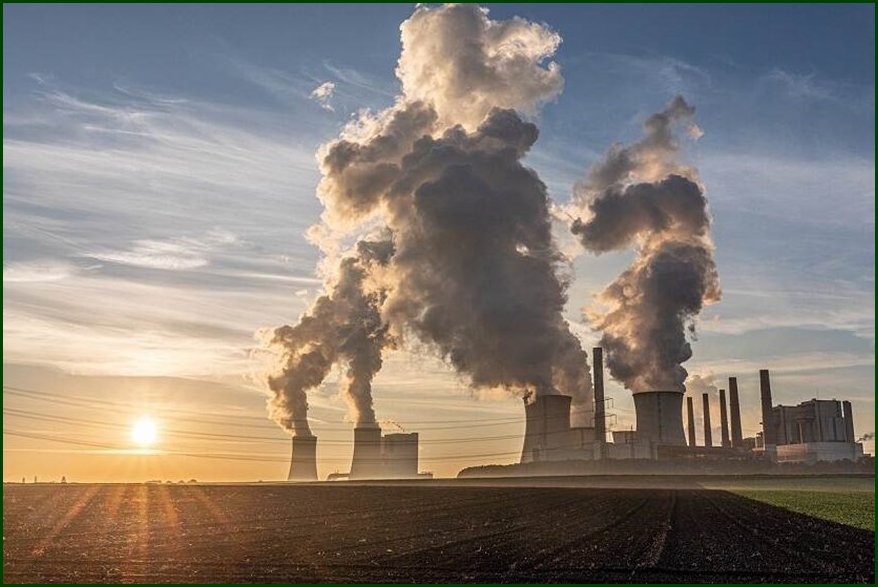
The latter has one of the lowest greenhouse gas reduction rates, 20% since 1990. Greenhouse gas emissions in Poland were 10 tons per capita in 2020, according to Eurostat data cited by Ziarul Financiar. However, between 2011 and 2020, Poland also managed to increase its energy production by 29% by combining coal-fired power plants with environmentally friendly energy sources such as wind and solar. By comparison, Romania’s coal-fired power plants, which produced 5,300 MW a decade ago, now supply less than half, turning the country from a net energy exporter to an importer for the past three years in a row. EU greenhouse gas emissions are estimated to have increased this year as economies recovered from shutdowns due to the pandemic. Eurostat data show that the Netherlands (-9%), Finland (-1%) and Sweden (-0.6%) were the only ones to record a drop in emissions in the first quarter of 2022 compared to the same period last year. Bulgaria (+38%), Malta (+21%) and Ireland (+20%).
Agricultural sector
Romania, 4th place in EU wheat production by 2022
Germany and Poland are the only countries in the top five with higher production than in 2021.
With few exceptions, the five largest wheat producers in the European Union maintained their top positions, according to data from Eurostat, the European statistical office. Romania dropped from 4th to 6th place in 2020, due to a 40% drop in production due to the drought, and between Spain and Italy there is a battle every year for 5th place in the top five largest producers in the EU.
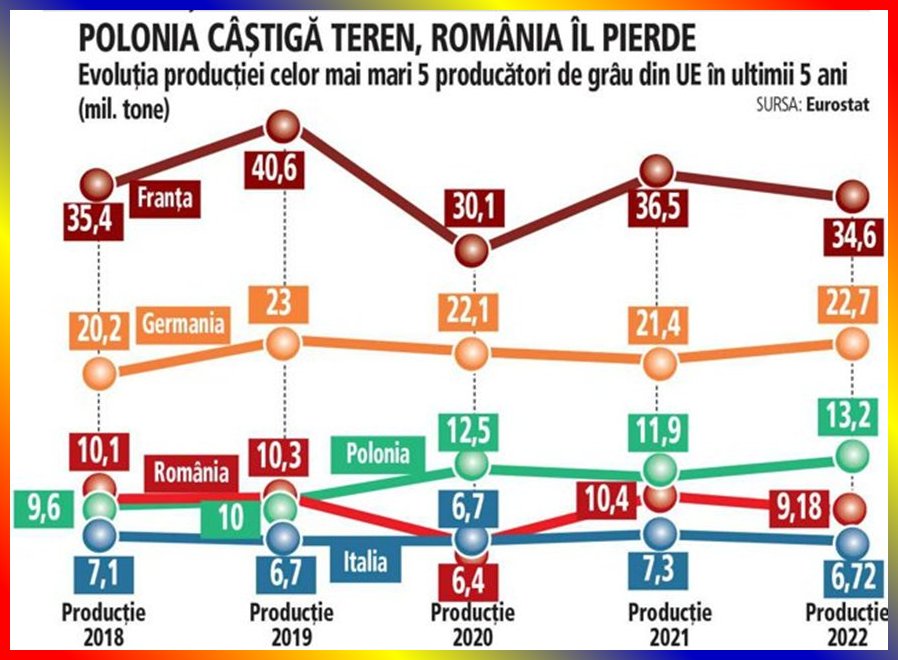
In 2022, with the 2022 harvest of 9.18 million tons of wheat collected from 2.1 million hectares, Romania ranked fourth in the EU. The largest producer of wheat in the EU is France, followed by Germany and Poland. Wheat production increased in 2022 compared to last year only in Germany and Poland, while production decreased in Romania, as well as in France and Italy, according to Eurostat data. However, the positions of the players in the top five remained unchanged from last year.
Agricover needs financing to boost its expansion
Agricover Holding engaged Wood & Company for consulting to explore financing options, including through an initial public offering of shares on the local market, followed by the listing of the shares on the Bucharest Stock Exchange (BVB).

The group needs financing to fuel its expansion, according to a report published at BVB, where its bonds are traded. No decision has yet been made on the desired financing path, the company’s management stressed.
“Such a decision will be made only after evaluating a number of criteria, including market conditions and feedback from potential investors,” the report reads.
Currently, Agricover Holding has a EUR 40 mln bond issue that is traded at BVB. The bonds were launched in 2021 and mature in 2026. They have a coupon of 3.5% but trade at a yield of 2.53%.
Where are the most expensive and cheapest hectares of agricultural land in the EU?
Arable land has become more expensive in Romania than last year and more expensive than in other EU countries, such as Bulgaria, Hungary or even France. Conversely, a hectare of arable land in Romania is almost 10 times cheaper than in the Netherlands, a country where this resource is extremely limited. The average price of a hectare of arable land in the European Union in 2021 ranges between €3,661 in Croatia and €47,290 in Luxembourg, according to data recently published by Eurostat. But Eurostat points out that this difference is likely to be even larger because data for 2021 is not available for all member states and in 2020 the average price of a hectare of arable land in the Netherlands was 71,225 euros.
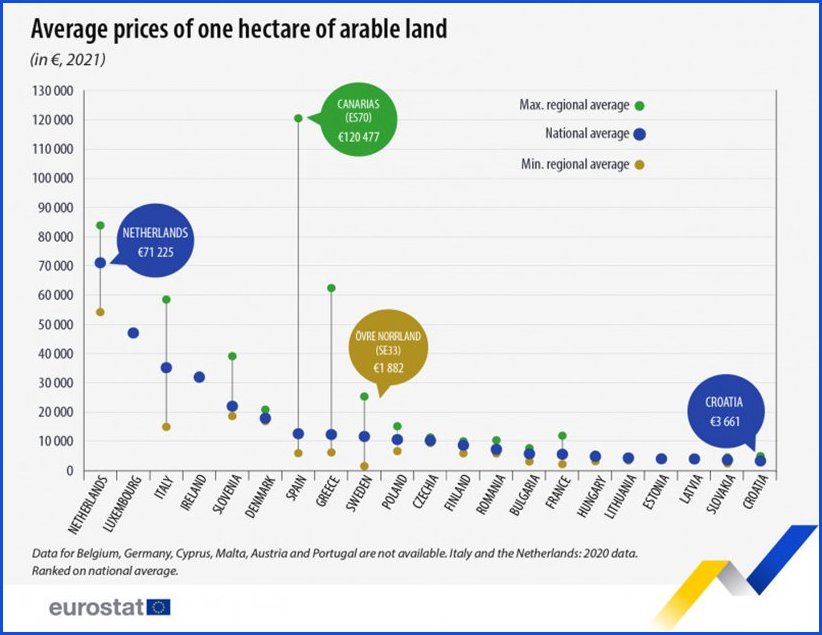
In the case of Romania, the average price of a hectare of arable land last year was 7,601 euros, compared with 7,163 euros in 2020.
By comparison, the average price of a hectare of arable land in 2021 was 6,096 euros in Bulgaria, 5,940 euros in France and 5,187 euros in Hungary.
Other member states where the average price of a hectare of arable land is lower than in Romania are: Lithuania, Estonia, Latvia, Slovakia and Croatia.At the regional level, according to available data, the highest price for a hectare of arable land was recorded in the Canary Islands region of Spain (with an average of 120,477 euros per hectare), and the lowest prices in the Ovre Norrland region of Sweden (with an average of 1,882 euros per hectare).
In the case of Romania, the highest prices for arable land are in the Bucharest-Ilfov region (10,707 euros for one hectare) and the lowest in the Northwest region (6,206 euros for one hectare). In both cases, prices are lower than in 2020.Eurostat points out that in most regions of the European Union, arable land is more expensive than grassland. Exceptions are the Spanish regions of Asturias and Madrid, as well as the Sostines region of Lithuania, where a hectare of pasture is more expensive than a hectare of arable land.
The average price of a hectare of pasture varied in 2021 between a minimum of 1,423 euros in Bulgaria and a maximum of 41,930 euros in Luxembourg, but in the Netherlands it was 59,065 euros, according to 2020 data. According to Eurostat, the price of arable land depends on several factors, including national legislation, climate, proximity to transport networks, soil quality, irrigation systems and market forces related to supply and demand.
DRN Advisory: We have plenty of member experts who are happy to show new members how to get started if they are considering a branch in Romania. A message to info@dutchromaniannetwork.nl will make you wiser!
3-year state aid scheme approved for vegetable, fruit and potato producers.
Agricultural producers of vegetables, fruits and potatoes will be able to benefit from a state aid scheme to subsidize 20% of the value of marketed production for 3 years. The grants awarded remain within the annual limit of 100,000 euros for authorized natural persons, individual companies and family businesses and 300,000 euros for cooperatives and producer groups/organizations, respectively. The initiators show that the producers of vegetables, fruits and potatoes are currently facing the consequences of the situation resulting from the armed conflict in Ukraine, namely the destabilization of prices, both for agri-food products and especially for raw materials needed by the producers of vegetables, fruits and potatoes in sorting, packaging, labeling and transporting products, as well as the disruption of supply chains.
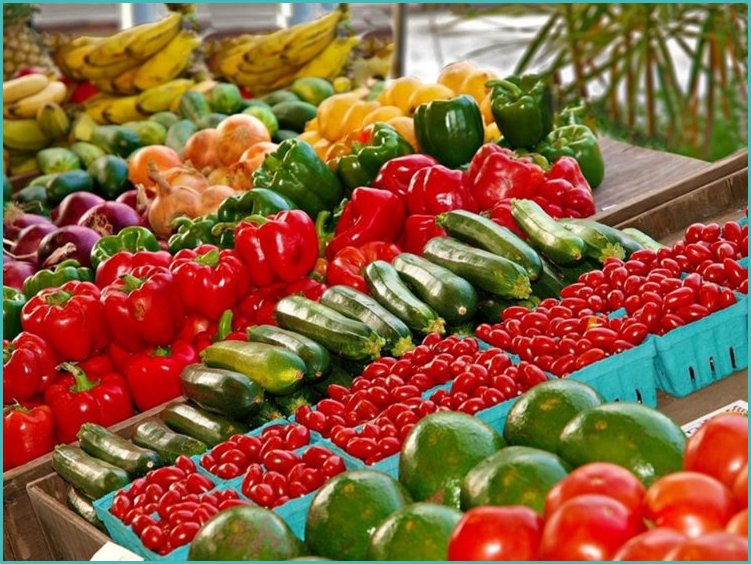 Thus, the proposed scheme would reduce the negative impact on food security during a crisis situation, regardless of its cause or nature According to the project, the aid will be granted to applicants who cumulatively meet the following conditions: – be a legal entity, a natural person registered before the tax authorities according to the provisions of Government Emergency Ordinance No. 44/2008 regarding the conduct of economic activities by authorized natural persons, individual enterprises and family enterprises, cooperative according to the Law on Agricultural Cooperation No. 566/2004 and Law 31/1990 on commercial enterprises, groups/organizations of producers, as the case may be; – owning and operating land cultivated with vegetables, potatoes, fruits, plantations of fruit trees, plantations of fruit bushes and/or semi-shrubs, plantations of table grapes intended for human consumption; sell vegetables, potatoes and/or fruits; – the minimum area intended for cultivation in protected areas is 500 m²; – provide proof of the absence of debts to the state budget by means of supporting documents showing that the value of the production sold in the quarter for which the aid is requested was at least 1.000 euros; – not be in reorganization, liquidation or bankruptcy on the date of access to state aid without a final court ruling declaring bankruptcy by the said date. The amounts granted as state aid under this law will not be subject to foreclosure by seizure if the foreclosure proceedings have been initiated against their beneficiaries.
Thus, the proposed scheme would reduce the negative impact on food security during a crisis situation, regardless of its cause or nature According to the project, the aid will be granted to applicants who cumulatively meet the following conditions: – be a legal entity, a natural person registered before the tax authorities according to the provisions of Government Emergency Ordinance No. 44/2008 regarding the conduct of economic activities by authorized natural persons, individual enterprises and family enterprises, cooperative according to the Law on Agricultural Cooperation No. 566/2004 and Law 31/1990 on commercial enterprises, groups/organizations of producers, as the case may be; – owning and operating land cultivated with vegetables, potatoes, fruits, plantations of fruit trees, plantations of fruit bushes and/or semi-shrubs, plantations of table grapes intended for human consumption; sell vegetables, potatoes and/or fruits; – the minimum area intended for cultivation in protected areas is 500 m²; – provide proof of the absence of debts to the state budget by means of supporting documents showing that the value of the production sold in the quarter for which the aid is requested was at least 1.000 euros; – not be in reorganization, liquidation or bankruptcy on the date of access to state aid without a final court ruling declaring bankruptcy by the said date. The amounts granted as state aid under this law will not be subject to foreclosure by seizure if the foreclosure proceedings have been initiated against their beneficiaries.
Good opportunities for Dutch agrifood companies and investors in Romania
Agriprogress has been active in and with the Romanian agribusiness since 2007. More than 60 Dutch investors/companies including farmers have been supported to develop their businesses in this promising country.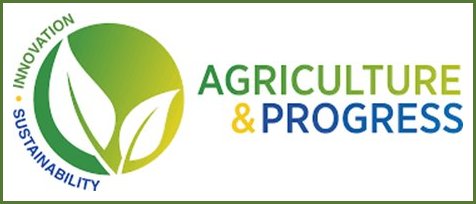 In the Netherlands, the policy and strategy is to move toward more nature-inclusive agrifood chains. Recycled agriculture, organic farming, water quality, biodiversity, plant-based human proteins, animal welfare and reduction in the use of fertilizers and plant protection products are central to this.
In the Netherlands, the policy and strategy is to move toward more nature-inclusive agrifood chains. Recycled agriculture, organic farming, water quality, biodiversity, plant-based human proteins, animal welfare and reduction in the use of fertilizers and plant protection products are central to this.
The goal is to buy out about 800 farms and reduce ammonia emissions by 30%. EUR 25 billion is available to make the transition in the Dutch countryside. The practice is that bought-out farms have to pay hefty taxes (“one pocket in, another pocket out”).
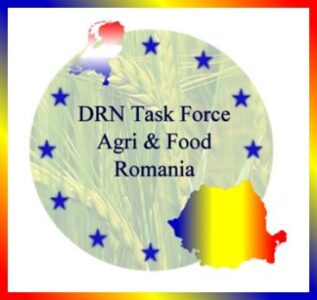
In Romania, the strategy is to develop more value-added activities in agri-food chains, this means livestock breeding but also the development of processing, sorting and packaging, storage, transportation including marketing activities, this with subsidies ranging from 50-90 %. How can we help you? We search and select locations, we do study visits, we make business plans, we do the legal check and due diligence, we can help you with the startup in Romania. We regularly have new offers for farms/gardens/businesses who want to sell, so check our website regularly. Pictured is a 2 acre greenhouse and fruit garden which is currently for sale.
Call us for consultation at +31653782889 or email: info@agriprogress.com. Website www.agriprogress.com Offices: Deventer and Bucharest.
DN Agrar Group, controlled by the Dutch de Boer family, tripled its business in the first 9 months
DN Agrar Group SA, Romanian livestock company controlled by the Dutch de Boer family, with cow’s milk production and vegetable production, posted a turnover of 103.23 million lei (+221.45%) and a net profit of 10.6 million lei (+249.5%) in the first nine months of the year, compared to the analyzed period from 2021. The acquisition of the farms Lacto Agrar (made in December 2021) and Apold (made in April 2022) contributed more than 5 million lei to DN AGRAR’s profitability, representing more than 48% of the net profit made, according to the financial results for the 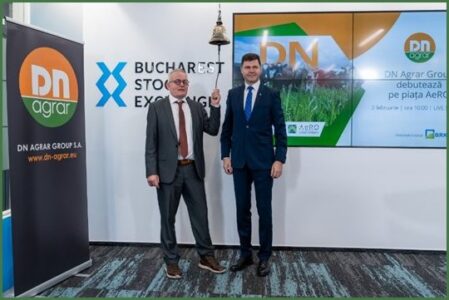 first 9 months of 2022
first 9 months of 2022
This year marked the consolidation of the DN AGRAR Group’s activity and new investments, with the company’s plans and strategy continuing in the direction set. The completion of the investment works within the Apold farm allows us to operate the two milking parlors at full capacity, in 3 shifts, with a 50% increase in operational capacity, until the end of the year.
As for Lacto Agrar’s farm, in September 2022 we started the project to build a new pool for manure. We are in the phase of preparing the land on which we will build the basin and we estimate completion of the construction in early 2023, said Jan Gijsbertus de Boer, chairman of the board of directors of DN Agrar Group SA.
The group includes the companies DN Agrar Apold SRL (whose activity consists of raising dairy cattle), DN Agrar Calnic SRL (cereal cultivation (excluding rice), legumes and plants producing oil seeds), DN Agrar Holding SRL (cereal cultivation ( excluding rice), legumes and plants producing oil seeds), Prodag Garbova SRL (purchase and sale of own real estate). At the DN AGRAR farm level, the amount of milk delivered in the first 9 months of 2022 increased by more than 2.7 million liters of milk, respectively, by more than 8.3% compared to the same period of 2021, a trend that continues.

The farm has over 10,500 head of dairy cows and young stock and a cultivated area of nearly 7,000 acres of land. The goal is to reach up to 12,500 dairy cows and young stock in the near future. The 15 companies that are part of DN Agrar Group SA’s portfolio include 4 farms, whose main activity is both the rearing of dairy cattle (Prodlact farm) and the production of cow’s milk (Cut, Lacto Agrar and Apold farms). The company offers logistics and cow transport with specialized vehicles both nationally and in Europe. In the area of cereals, the group’s farms currently cultivate more than 7,000 hectares in the provinces of Alba, Sibiu and Hunedoara, and the goal is to reach a cultivated area of 10,000 hectares through other farms with vegetable and/or or livestock production.
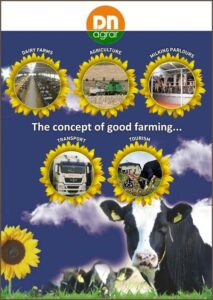 The productions obtained from established crops are used both to secure the feed base for their own farms and to pay rent to tenant farmers who choose grain. The productions obtained from barley and sunflower crops are used for third parties. In July 2021, DN Agrar Group attracted 24.8 million lei from investors after a private placement in which the company sold 25.7% of its share capital to acquire the Lacto Agrar farm , according to the target in the issue prospectus. Before the acquisition of Lacto Agrar, crop production, livestock production and farm management were integrated into the agribusiness of the DN Agrar group of companies, so that after the completion of the transaction a transition process of production and management activities within the activity was not necessary farms. The rest of the purchases were financed through a credit facility, recorded as long-term debt.
The productions obtained from established crops are used both to secure the feed base for their own farms and to pay rent to tenant farmers who choose grain. The productions obtained from barley and sunflower crops are used for third parties. In July 2021, DN Agrar Group attracted 24.8 million lei from investors after a private placement in which the company sold 25.7% of its share capital to acquire the Lacto Agrar farm , according to the target in the issue prospectus. Before the acquisition of Lacto Agrar, crop production, livestock production and farm management were integrated into the agribusiness of the DN Agrar group of companies, so that after the completion of the transaction a transition process of production and management activities within the activity was not necessary farms. The rest of the purchases were financed through a credit facility, recorded as long-term debt.
DN Agrar Group SA is a group of companies with a Dutch majority stake operating in central Transylvania in the provinces of Alba, Sibiu and Hunedoara. The group is listed on the Bucharest Stock Exchange under the symbol DN as of February 2, 2022 . The main areas of work are animal husbandry, agricultural crop production, agricultural services, logistics, transportation, tourism and business and management consulting services. As of Sept. 30, 2022, the company had 239 employees.
Government Sector
New ambassadors appointed in Romania and Moldova
In Moldova based in Chisinau: Fred Duijn who knows the region well having previously served as secretary at the embassy in Bucharest. It is the first ambassador to this country because in the past it alternately belonged to Romania and Ukraine.
In Romania, Willemijn van Haaften based in Bucharest has been appointed as ambassador now flexibly deployable ambassador from the TZ flexpool. Little is known about her except that she was active as a diplomat in Germany and the Middle East.
Fiscal developments
Mazars-Romania: EU VAT gap has narrowed: by 2020, member states have recovered €31 billion
- In 2020, Romania again recorded the largest VAT collection gap at the EU level, with a 35.7% loss in VAT revenue.
- EU countries lost 93 billion euros in VAT revenue.
- SAF-T reporting and e-invoicing can help boost VAT collection.
On Dec. 8, the European Commission published the VAT Gap Report for 2020. The good news is that at the European Union (EU) level, VAT collection increased again (by about 2%), with Member States recovered about 31 billion euros compared to the previous year.
The lowest VAT collection deficits were recorded by Finland (1.3%), Estonia (1.8%) and Sweden (2%), and the highest by Romania (35.7%) and Malta (24.1%).
For Romania, VAT collection remains a major challenge, as the shortage continues to rise year after year and is the highest in the EU. As in 2019, Romania also lost about a third of the VAT that should have been collected in 2020. Figures show a loss of €7.4 billion in 2020. The delayed reform and digitization of the tax administration inevitably delayed the improvement of VAT collection, and the other measures taken did not yield results.
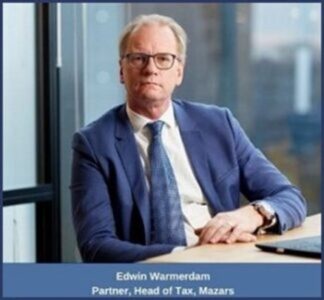 “Romania’s National Recovery and Resilience Plan (NRRP) includes a package of measures through which the Ministry of Finance implemented the most comprehensive reform of the tax administration based on digitalization, with the aim of reducing the VAT collection deficit by 5 percentage points by 2026 (compared to until 2019). Some of the measures are already underway: SAF-T reporting (Standard Audit File for Taxes), connecting electronic cash registers to ANAF servers, electronic invoicing or the RO e-Transport system for monitoring goods shipments with a high tax risk, said Bianca Vlad, tax partner, Mazars Romania.
“Romania’s National Recovery and Resilience Plan (NRRP) includes a package of measures through which the Ministry of Finance implemented the most comprehensive reform of the tax administration based on digitalization, with the aim of reducing the VAT collection deficit by 5 percentage points by 2026 (compared to until 2019). Some of the measures are already underway: SAF-T reporting (Standard Audit File for Taxes), connecting electronic cash registers to ANAF servers, electronic invoicing or the RO e-Transport system for monitoring goods shipments with a high tax risk, said Bianca Vlad, tax partner, Mazars Romania.
These measures based on real-time reporting could produce the most significant results from a collection perspective if we look at the experience of other member states. Authorities will have greater control over transactions conducted by traders, with real-time access to a large amount of data designed to help identify fraudulent transactions.
“The European Commission welcomes the initiatives of the Romanian authorities and mentions in its study that projections for 2021 indicate a narrowing of the VAT gap as a result of these digital reporting measures, ” said Miruna Cîrstea , Assistant Tax Manager, Mazars Romania.
We are curious to see if the Romanian tax authorities’ measures will produce the expected results. The willingness and ability of tax authorities to analyze and process a significant amount of data will be essential as the tax inspection process faces a major paradigm shift.
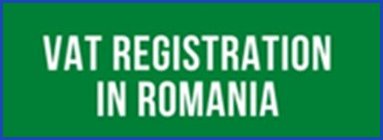 “At the same time, also late last week, the European Commission proposed a series of measures to modernize the current VAT system and adapt it to the digital age. Three key actions have been announced and will be implemented gradually between 2023 and 2028. The first concerns the implementation of real-time digital reporting based on mandatory e-invoicing, along with the reform of other reporting requirements (e.g., lists will be eliminated). The second action involves updating the VAT rules for short-term passenger transport and accommodation platforms, and the last action is aimed at introducing a single VAT registration across the EU, by expanding the scope of the existing One Stop Shop (OSS) and Import One Stop Shop (IOSS) schemes,” said Alexandru Stanciu, Senior Tax Manager, Mazars Romania.
“At the same time, also late last week, the European Commission proposed a series of measures to modernize the current VAT system and adapt it to the digital age. Three key actions have been announced and will be implemented gradually between 2023 and 2028. The first concerns the implementation of real-time digital reporting based on mandatory e-invoicing, along with the reform of other reporting requirements (e.g., lists will be eliminated). The second action involves updating the VAT rules for short-term passenger transport and accommodation platforms, and the last action is aimed at introducing a single VAT registration across the EU, by expanding the scope of the existing One Stop Shop (OSS) and Import One Stop Shop (IOSS) schemes,” said Alexandru Stanciu, Senior Tax Manager, Mazars Romania.
Mazars’ specialists will continue to monitor the authorities’ efforts to increase fiscal revenues and the effects this will have on the business environment, which faces unprecedented challenges in the near term.
Logistics & Transportation Sector
E. van Wijk Logistics active in Romania for another 30 years
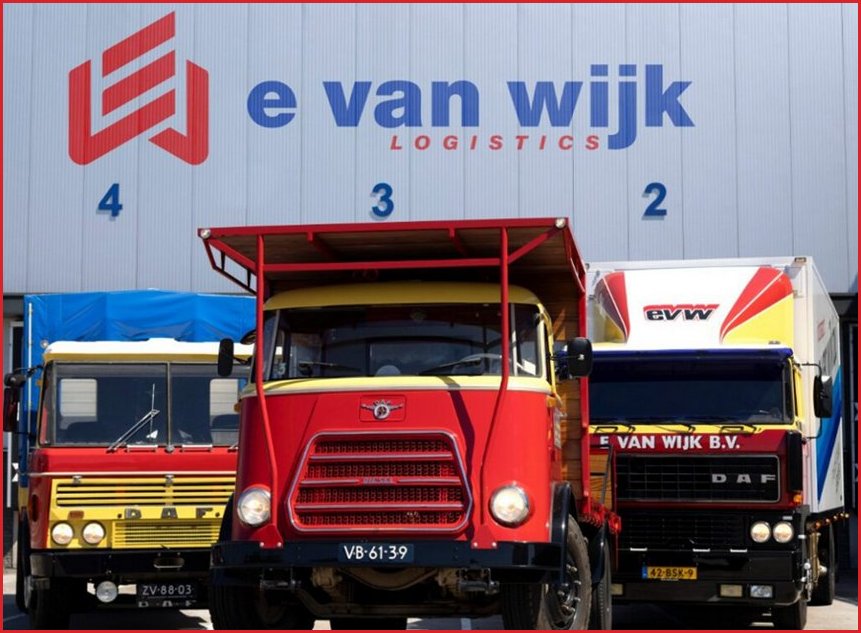
In 2023, the next milestone
Last year we celebrated 30 years of E. van Wijk Logistics in Romania. Next year, however, there will be a new milestone. Ewout: “For us, this anniversary is a nice prelude to our 75th anniversary next year. After all, my grandfather started the company back in 1948 with a single truck in the Brabant village of Genderen. 75 years is of course a wonderful anniversary that says a lot about a company. After all, it stands for a piece of entrepreneurship, passion, ambition and for successfully living up to the role as a reliable partner. In our family business, together with our employees, partners and clients, we think this is something to be proud of. And we will of course celebrate this next year in an appropriate way.”
H.Essers commits to hydrogen
H.Essers is convinced that hydrogen is indispensable to reduce the transportation sector’s carbon footprint. We are therefore committed to further developing this technology and infrastructure. For the past two years, we have been a contributing member of the HyTrucks consortium, which brings together more than 70 stakeholders from five European countries involved in the hydrogen supply and demand chain. HyTrucks developed a robust European project and expects a decision on European grants soon.
The importance of hydrogen
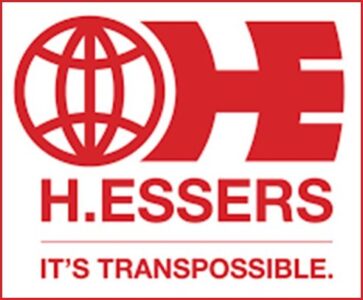 As a leading logistics player in Europe, H.Essers actively seeks opportunities for sustainable transport. We seek a modal shift to rail and waterways, avoiding road transportation, eliminating emissions, reducing congestion and solving the driver shortage problem. Unfortunately, not all transportation is possible by rail or water, so it is important to reduce the impact of transportation by truck. Diesel trucks are slowly giving way to electric vehicles (for shorter distances) and hydrogen-powered vehicles (for longer distances). Biofuels such as HVO and bio-LNG are already available and will remain relevant in the long run.
As a leading logistics player in Europe, H.Essers actively seeks opportunities for sustainable transport. We seek a modal shift to rail and waterways, avoiding road transportation, eliminating emissions, reducing congestion and solving the driver shortage problem. Unfortunately, not all transportation is possible by rail or water, so it is important to reduce the impact of transportation by truck. Diesel trucks are slowly giving way to electric vehicles (for shorter distances) and hydrogen-powered vehicles (for longer distances). Biofuels such as HVO and bio-LNG are already available and will remain relevant in the long run.
The success of hydrogen depends on the availability of hydrogen trucks and their range, payload, refueling speed and current infrastructure. “That’s the problem,” says Sustainability Project Manager Yannick Dylst. ‘The high production cost of green hydrogen and hydrogen technology limits customer demand; and no demand means no investment. The result is a bit of a chicken-and-egg situation.
KLG expands with showpieces from DAF
With the purchase of the new trucks, including the first 50 DAF XG+ trucks, KLG is once again living up to its name. KLG’s fleet will be replaced to new models after 3 years of deployment. So KLG is hitting the road with these 50 of DAF’s newest flagships and building its future.
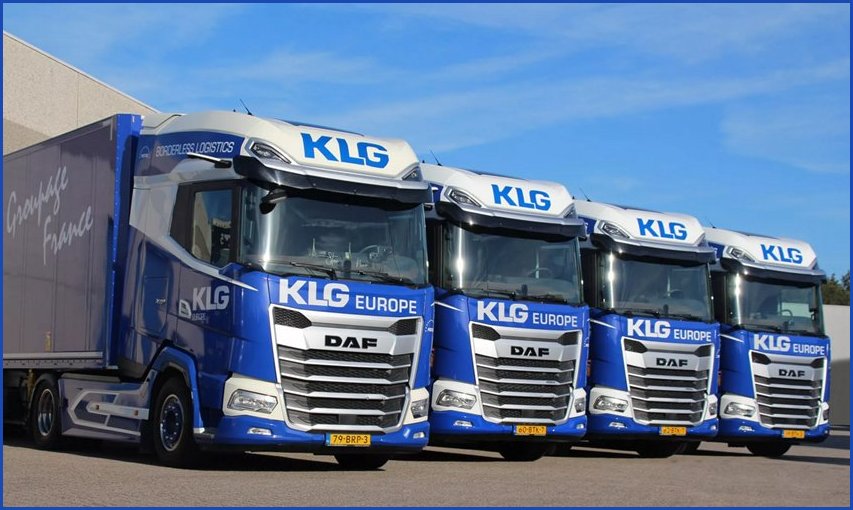
That KLG has been actively building its future for years and sees its employees as the core of the organization is abundantly clear. Not only the vehicle fleet but also the new building for the Eersel branch are examples of this. The new office building, an in-house workshop for fleet maintenance and a 10,000 square meter cross-dock will help KLG respond to changing demand in the logistics market. But can also offer growth to its customers and continue to facilitate a good workplace for its highly committed employees.
Sector Infrastructure
Romanian highway shortage to be drastically addressed
During the last five years, the shortage of highways is rapidly being made up, thanks in part to support from the European Union. Recently, the Transport Operational Program, the mechanism through which the European Union co-finances infrastructure and transport projects on a non-refundable basis with European funds in the period 2021 – 2027, was approved by Brussels, Transport Minister Sorin Grindeanu announced.
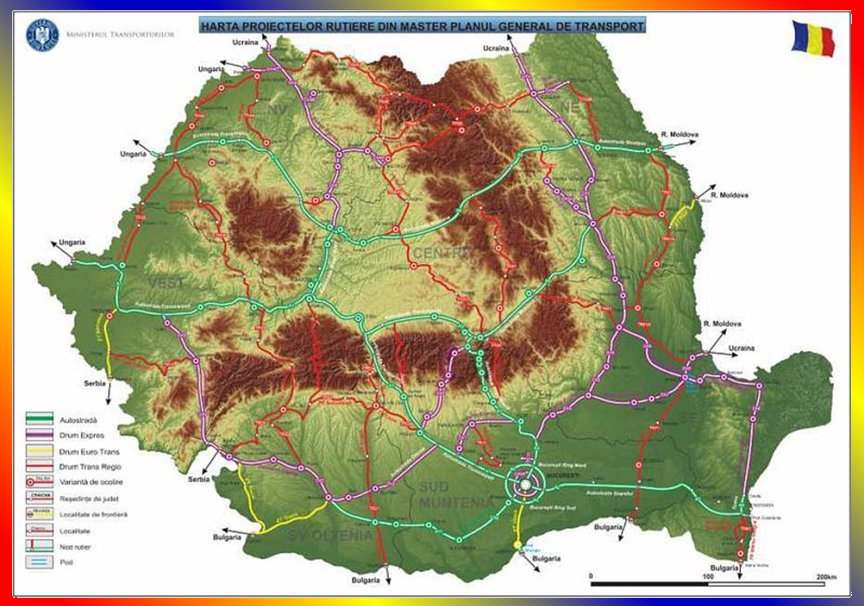
Road projects from the Transportation Master Plan,Photo: MT
“The Transport Operational Program has been approved by the European Commission. The amount allocated through the POT 2021-2027 is 9.6 billion euros, of which 4.65 billion are non-refundable European funds,” explained Grindeanu .According to him, the funds will be used over the next 7 years for the development of Romania’s major road, rail (including metro) and marine infrastructure.
Priority highways for non-repayable European funds for the period 2021-2027
Among the projects to be funded through POT 2021-2027 are:
– Sibiu-Pitesti highway
– Sibiu-Brașov highway
– Ungheni-Iași-Târgu Neamț-Târgu Mureș highway (minus PNRR-funded final sectors)
– Brașov-Bacău highway
– Timișoara-Moravița freeway
– Pașcani-Siret Highway.
“Expansions and modernizations of railroad infrastructure (including the metro network) will also be financed, as well as projects to improve navigation conditions on the Danube,” Grindeanu said.
Economic Developments
The number of newly established companies with foreign capital in Romania increased by 30.7% in the first 10 months of 2022
243,022 companies with foreign equity participation operate in Romania.
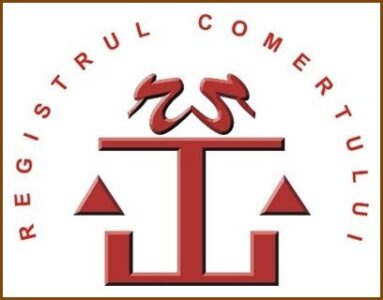 The number of newly established companies with foreign capital in Romania increased by 30.7% in the first 10 months of 2022, compared to the similar period in 2021, to 6,175 units, according to data centralized by the National Office of the Trade Register.
The number of newly established companies with foreign capital in Romania increased by 30.7% in the first 10 months of 2022, compared to the similar period in 2021, to 6,175 units, according to data centralized by the National Office of the Trade Register.
The 6,175 new companies had total issued capital of more than $35 million, 2.7% lower than that of companies registered between January and October 2021 of more than $36 million.
As of October 2022, 652 companies with foreign equity participation were registered.
Depending on the fields of activity, in September most registrations were registered in wholesale and retail trade, auto and motor repair (24.69% of the total), professional, administrative, scientific and technical activities (21.78%), and transportation, storage and communication (17.18%).
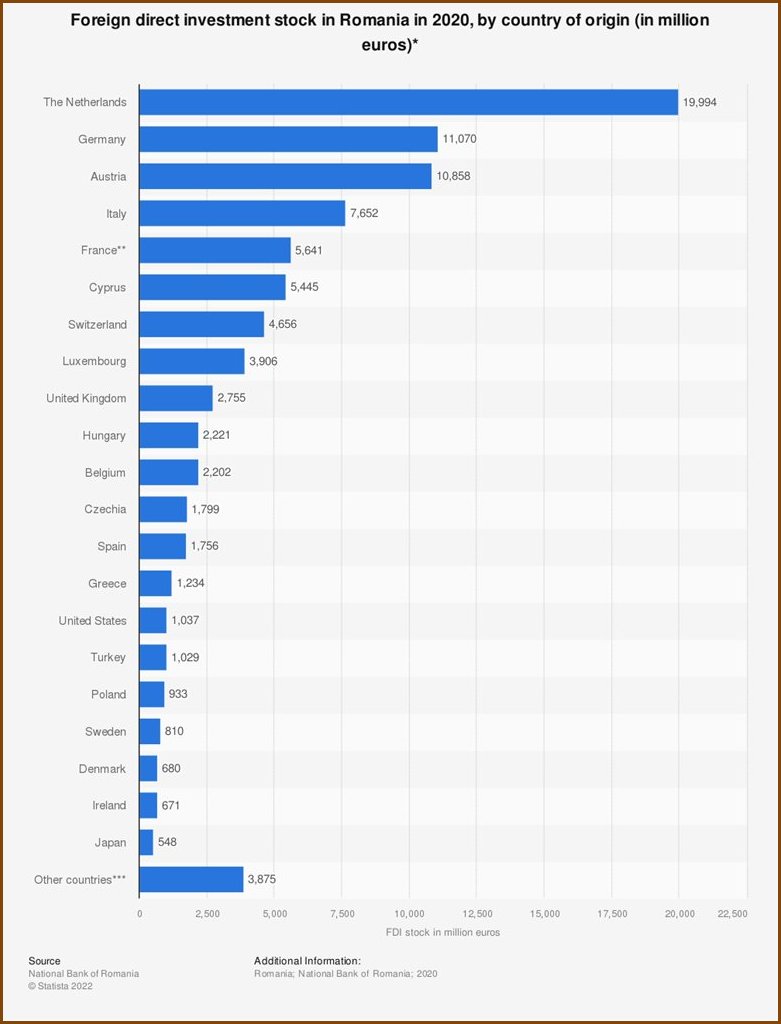
At the end of October 2022, there were 243,022 companies with foreign equity participation in Romania. The value of the issued capital was more than $67 billion. Most foreign investors are from Italy, 51,579 (placed capital of $4.009 billion) respectively, but the highest value of social capital belongs to 5,842 Dutch companies, $12.599 billion respectively.
The above graph of the situation in 2020 indicates that the Dutch top position is unchanged and still rising.
Shipbuilding Sector
OPINION: Maritime manufacturing industry deserves targeted government policy
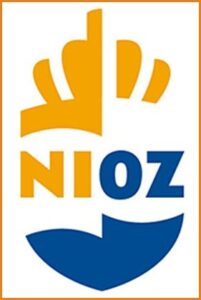 The Royal Netherlands Institute for Sea Research (NIOZ), part of the Netherlands Organization for Scientific Research, is having a new flagship built. The “Anna Weber-van Bosse” will be the cream of the crop among scientific research ships. Maximum sustainability and future-proof preparedness for innovations. A calling card for the Dutch maritime manufacturing industry… At least, it could have been, were it not for the fact that the ship will be built in Spain.
The Royal Netherlands Institute for Sea Research (NIOZ), part of the Netherlands Organization for Scientific Research, is having a new flagship built. The “Anna Weber-van Bosse” will be the cream of the crop among scientific research ships. Maximum sustainability and future-proof preparedness for innovations. A calling card for the Dutch maritime manufacturing industry… At least, it could have been, were it not for the fact that the ship will be built in Spain.
This is a blow to the Dutch maritime manufacturing industry, which is in a tough spot. The effects of the corona pandemic have hardly been overcome. Commodity and energy prices are going through the roof. Companies are losing orders to Chinese shipyards, which are heavily subsidized by the government. On top of that, we see companies being extra affected by the effects of the war in Ukraine.
The unstable world order makes us realize again how important it is to have our own strong industry and not depend on foreign countries for everything. In the July 8 letter from Economy and Climate Minister Micky Adriaansens on the cabinet’s proposed industrial policy, she fully endorses this.
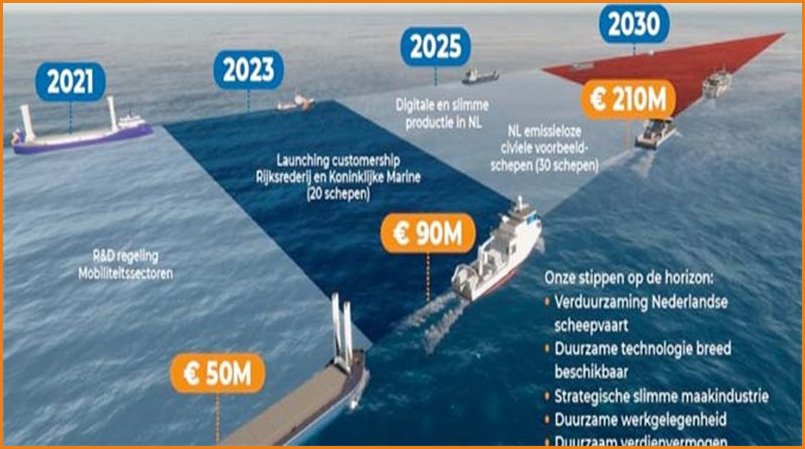
In that letter, the cabinet clearly marks the important role of industry in our society and speaks in favor of maintaining a significant industrial base in the Netherlands: between 10-15% GDP. Funds for contribution to research and innovation are announced. This is what we are betting on from the maritime sector by developing a Master Plan in order not to lose our leading position in a number of markets. But that’s not enough. Couldn’t it be more concrete?
For example, almost all countries around us have set up a support package for companies disproportionately affected by the war in Ukraine. Netherlands did not. Also, when tendering for defense or other large or strategically important contracts, many EU countries have constructions to protect or prioritize their own industries. In the Netherlands, we are often the best behaved but not the brightest boy in the class in this regard and end up getting the member on the nose after all.
With the development and construction of the “Anna Weber-van Bosse,” government could have given a boost of many tens of millions of euros to Dutch shipbuilding and the many (SME) companies associated with it as suppliers. This first ship in the extensive fleet renewal task of ships for public service could have been an investment in the development, sustainability and employment of our patriotic manufacturing industry. An opportunity that comes along once every thirty years … but alas.
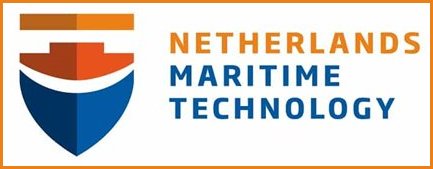 The maritime manufacturing industry is of strategic importance to the Netherlands. It is a supplier of maritime technology and ships used in a variety of essential applications for society. These include extraction of food and energy, construction and maintenance of ports and waterways, transportation of people and goods, and defense and security tasks. Therefore, within the framework of Dutch and European strategic autonomy, the Dutch government benefits from a strong maritime manufacturing industry and should give industrial policy hands and feet with concrete measures, including spending public funds in the Netherlands for its own fleet.
The maritime manufacturing industry is of strategic importance to the Netherlands. It is a supplier of maritime technology and ships used in a variety of essential applications for society. These include extraction of food and energy, construction and maintenance of ports and waterways, transportation of people and goods, and defense and security tasks. Therefore, within the framework of Dutch and European strategic autonomy, the Dutch government benefits from a strong maritime manufacturing industry and should give industrial policy hands and feet with concrete measures, including spending public funds in the Netherlands for its own fleet.
Indirect support through R&D programs is important to strengthen an innovation base. Above that, our national manufacturing industry needs – as in our neighboring countries – to be supported more direct measures. The replacement of the State Shipping Company’s fleet is imminent. Within the rules of the game, let us work together to include our own maritime manufacturing industry in future government tenders.
There is a win-win in developing and building ships tendered with Dutch public money in the Netherlands. The Dutch government organizations will get high-quality ships, the Dutch maritime cluster will be strengthened and the companies will get wonderful business cards that will strengthen their international position.
Cabinet … The maritime future is now!
Lower House makes case for Dutch maritime defense industry
‘It is good that the Lower House is making the case for the involvement of the Dutch maritime and defense industry in the development of new submarines,’ said NMT, VNO-NCW and MKB-Nederland. On Nov. 22, the SGP submitted a motion calling on the Cabinet to ensure the involvement of Dutch industry in the construction of new submarines. A broad House majority supported the motion.
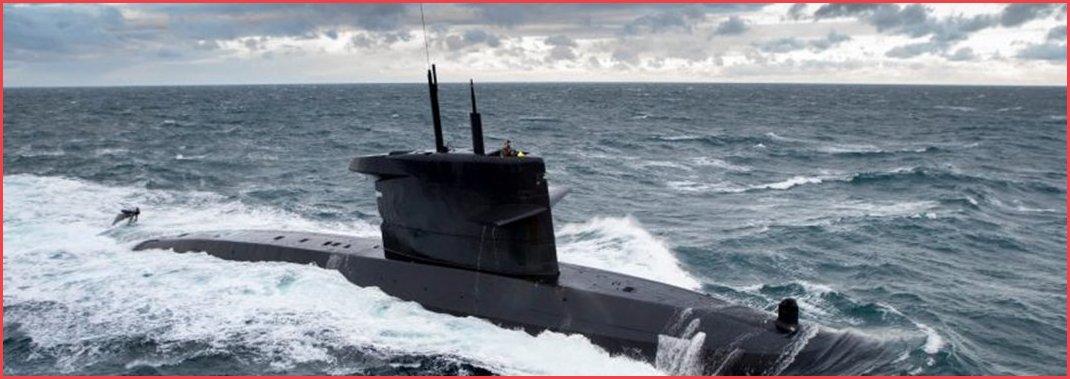
Capture commitment in an ICA
‘Without participation by Dutch companies, essential maritime knowledge and expertise for our country is at risk of being lost. With this, our own control over the deployability of our submarines is at stake. It is good that the Chamber recognizes this and calls on the cabinet to lay down the involvement of Dutch industry – including in the development of high-tech applications – in an industrial cooperation agreement (ICA) and take it into account in the awarding process. In this way, we avoid over-dependence on a foreign shipyard for the construction and maintenance of submarines,” the business organizations said.
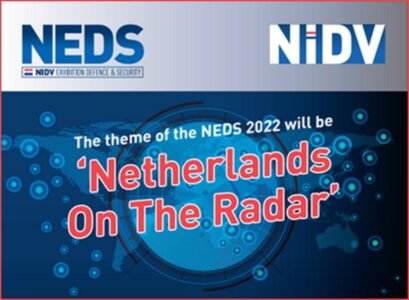
Importance of autonomous Dutch defense industry
‘The war in Ukraine and the Nord Stream 2 incident have shown that we cannot take our security situation for granted. This emphasizes the importance of a strong armed force supported by an autonomous Dutch defense industry. The replacement of the Walrus class is therefore ideally suited to further develop and strengthen the industrial knowledge present in our country.
NMT, VNO-NCW and MKB-Nederland and DRN previously called attention to the importance of the involvement of Dutch industry in the development of new submarines.
Women’s electric tug on TIME’s Best Inventions List 2022
US TIME Magazine has placed Damen’s first fully-electric harbor tug Sparky on TIME’s Best Inventions List 2022. As far as we know, this is the only Dutch invention on the list. The tug, an RSD 2513 design by Damen, is now deployed in the New Zealand port to the full satisfaction of client Ports of Auckland.
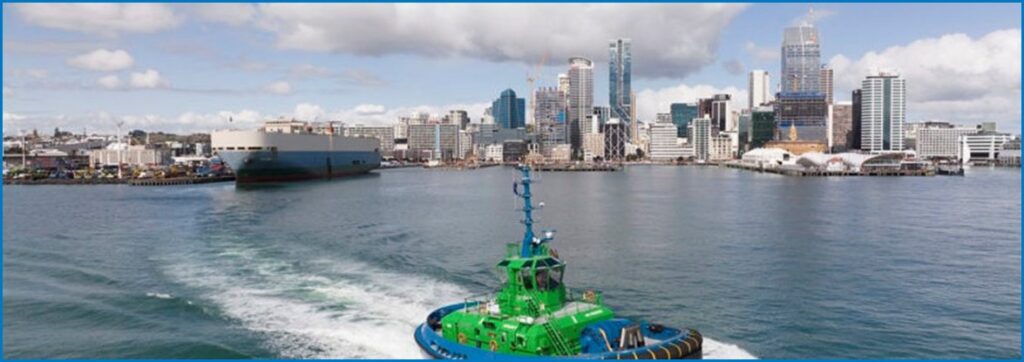
The TIME Best Inventions List is compiled by editors and correspondents around the world. Special attention is given to emerging sectors, such as electric vehicles, renewable energy and the metaverse. TIME Magazine then evaluated each candidate based on a number of factors, including originality, effectiveness, ambition and impact.
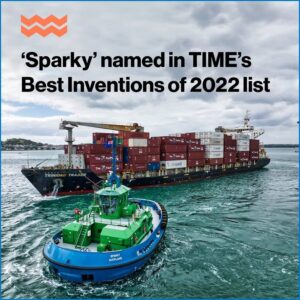 On the 2022 list, Sparky is among other innovations such as the IBM Two-Nanometer Chip, the smallest chip ever; Canada’s Molli Surgical, which has developed equipment for precision surgery to fight breast cancer; and MethaneSAT, which uses a satellite to detect methane leaks.
On the 2022 list, Sparky is among other innovations such as the IBM Two-Nanometer Chip, the smallest chip ever; Canada’s Molli Surgical, which has developed equipment for precision surgery to fight breast cancer; and MethaneSAT, which uses a satellite to detect methane leaks.
Both Damen and Ports of Auckland are proud of the award. “She is the world’s first electric tug with such a large capacity,” said Ports of Auckland CEO Roger Gray. “We are taking a concrete step toward the decarbonization and emission reduction of our port operations with this.”
Sparky recharges in just two hours and can then work for hours supporting four large ships in Auckland harbor with its 70-ton towing capacity before the batteries need to be recharged again. Sparky is expected to save 465 tons of CO2 emissions annually. In addition, this electric tug is low-noise, vibrates much less, and its expected operating costs are less than one-third those of a diesel tug.
European developments
Sweden assumed the rotating presidency of the
European Union on (January-June 23)
The rotating presidency of the European Union (EU) over from the Czech Republic. The member states holding the Union presidency work together for 18 months in groups of three, called “trios.” The current trio consists of France (Jan.-Jun. 2022), Czech Republic (July-Dec. 2022) and Sweden (Jan.-Jun. 2023).
Swedish presidency’s logo and priorities
The Swedish presidency’s priorities reflect the positions Sweden has traditionally supported in the EU, but also respond to the current geopolitical and economic challenges facing the Union, according to the Swedish government’s website.
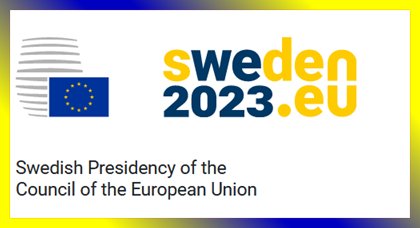 Security unit, resilience-competitiveness, prosperity (energy transition), democratic values and the rule of law are the themes central to the future Swedish presidency, Swedish Prime Minister Ulf Kristersson said in a speech on Dec. 12. , in the Riksdag (the Swedish parliament), when he presented the program of the Swedish presidency of the EU from Jan. 1, 2023.
Security unit, resilience-competitiveness, prosperity (energy transition), democratic values and the rule of law are the themes central to the future Swedish presidency, Swedish Prime Minister Ulf Kristersson said in a speech on Dec. 12. , in the Riksdag (the Swedish parliament), when he presented the program of the Swedish presidency of the EU from Jan. 1, 2023.
On foreign affairs, Sweden will pay more attention to the situation in Ukraine and the EU enlargement process. On the economy, the Swedish presidency will strive for unity in the current difficult crisis situation. In internal affairs, the future presidency will focus on migration policy, the fight against organized crime, terrorism and violent extremism. In the areas of social policy, jobs and health, Sweden shows that it will focus on reducing the risk of poverty and social exclusion as a result of the latest crises: the pandemic, the energy crisis and rising inflation. In addition, the Swedish presidency will actively pursue the EU’s goals of achieving climate neutrality by 2050, in parallel with increasing competitiveness, employment, food production and health and well-being. In this sense, the implementation of the European Green Pact is on the agenda in the first half of 2023,reports the website of the Swedish presidency.
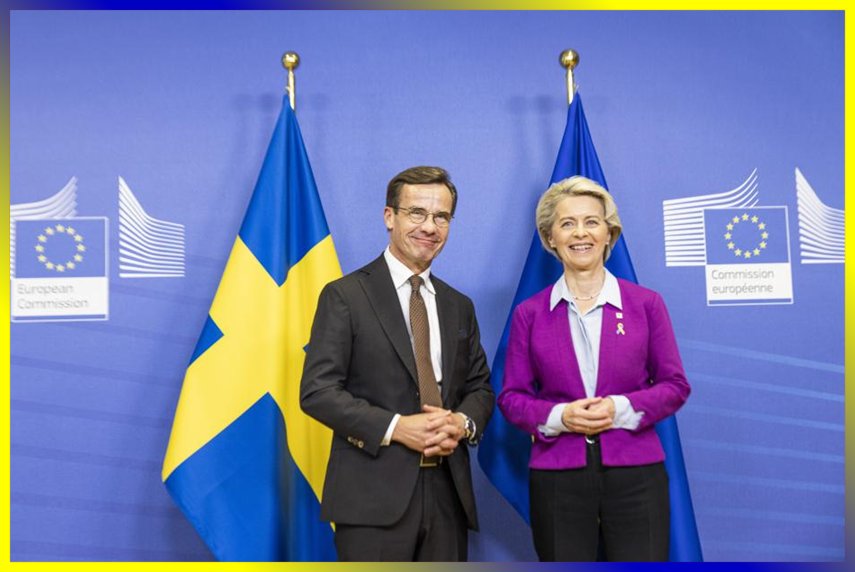
The logo of the Swedish Presidency of the EU Council is represented by the formula “sweden2023.eu,” written in yellow and white letters, on a blue background. By highlighting different parts of the logo, more messages are conveyed. “sweden eu” highlights Sweden’s role as holder of the presidency and its contribution to the Union. “we 2023” reflects the fact that Sweden, as holder of the presidency, is acting in the common interest of the Union, and “we eu” illustrates the community of EU member states and the importance of European construction for its citizens. Also, the connection between the letters “n” and “u” in the logo symbolizes solidarity among member states. The yellow dot in the logo represents determination and is a reference point for the common path forward of member states. The colors chosen are those common to Sweden and the EU: yellow and blue.
Sweden previously held the presidency twice: in 2001 and 2009. The presidency’s agenda in 2001 was dominated by enlargement, employment and the environment. The main agenda items in 2009 were the financial and economic crisis, climate change and the implementation of the new Lisbon Treaty.
Priority themes
The priority themes of the current France-Czech Republic-Sweden trio are https://data.consilium.europa.eu/, according to the website:
* the protection of citizens and their freedoms, with emphasis on the respect and protection of European values – democracy, the rule of law, gender equality, etc. – and on the consolidation of the Schengen area and European asylum and migration policy;
* promoting a new European growth and investment model based on green and sustainable growth and on European industrial and digital sovereignty;
* build a greener Europe, more equitable from a social perspective and more protective of the health of European citizens;
* A global Europe, a global player promoting multilateralism and renewed relations with its partners, in parallel with sharing a common vision of the 27 member states on strategic threats.
System rotating leadership ensures c
ontinuity
The next trio of presidencies of the Council of the European Union will be Spain (July-December 2023), Belgium (January-June 2024) and Hungary (July-December 2024).
The Presidency of the Council of the European Union is ensured by rotating every six months among the EU member states, during this period the member state ensures the continuity of the EU agenda within the Council and leads the meetings of this formation.
The system of rotating leadership was introduced by the Lisbon Treaty in 2009. The trio sets long-term goals and prepares a common agenda that identifies the key topics and issues the Council will address over an 18-month period. Based on this program, each of the three countries is preparing its own program, in more detail, for six months, according to the website www.consilium.europa.eu.
The Presidency has two main tasks: planning and leading meetings within the Council and its preparatory groups and representing the Council in relations with the other EU institutions.
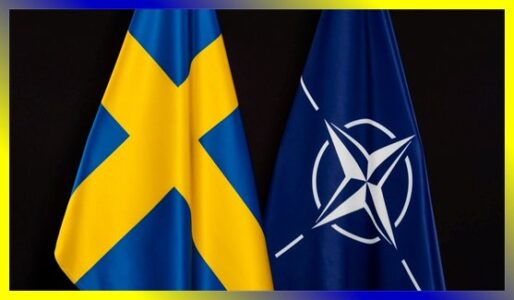 Regarding the planning and management of meetings, the Presidency leads the formal meetings of the various Council formations (with the exception of the Foreign Affairs Council), ensures that discussions are conducted in accordance with the Council’s rules and working methods, and also organizes, as well as informal meetings in Brussels and in the country hosting the rotating Presidency.
Regarding the planning and management of meetings, the Presidency leads the formal meetings of the various Council formations (with the exception of the Foreign Affairs Council), ensures that discussions are conducted in accordance with the Council’s rules and working methods, and also organizes, as well as informal meetings in Brussels and in the country hosting the rotating Presidency.
Regarding its role of representation, the EU Presidency represents the Council in relations with the other EU institutions, especially with the Commission and the European Parliament. Its role is to try to reach agreement on legislative files through so-called trialogues or through informal negotiation meetings and through Conciliation Committee meetings.
From a statistical point of view, legislation considered during a presidency depends on the initiatives of the EU’s strategic agenda. Some 500-700 bills are also discussed every six months, writes the website www.gov.si.
Schengen, the praise of folly or the impotence of politicians?
The good news is that European member states have formed a unity against the actions of the Russian Federation and the bad news is that some member states are behaving in such a way about Schengen that there are disagreements between some member states that threaten to weaken the position of European unity. Let us note that Schengen accession is independent of the war in Ukraine, but to some extent they are communicating vessels.
We limit ourselves in the following overview to a few key issues that largely define the picture. You as a reader may be shaking your head wondering why politicians make things so difficult for themselves (and others).
Rutte’s dead sparrow
He recently made the ruling that Romania can join Schengen. His initial doubt proved untenable, as he was simply unaware of all the investigations that had taken place under the (unofficial) Cooperative and Verification Mechanism (CVM) since 2011. So no 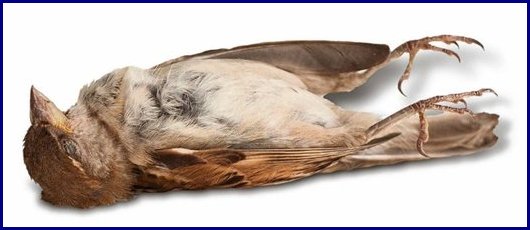 good turn. But it got worse, because he set the condition that, according to his information, Bulgaria was not ready to join. And since the unanimity principle is in force, therefore Bulgaria as a member state will vote against it. Bad luck for Bulgaria and good luck for Romania you will assume. After all, each country is judged on its merits anyway, as it did with Croatia. But by some strange twist of thought, both countries seem to be seen as a form of a federation, and everyone knows that there has never been a coupling of the two states. Logical because it is at odds with the fact that each acceding country should be judged on its own merits.
good turn. But it got worse, because he set the condition that, according to his information, Bulgaria was not ready to join. And since the unanimity principle is in force, therefore Bulgaria as a member state will vote against it. Bad luck for Bulgaria and good luck for Romania you will assume. After all, each country is judged on its merits anyway, as it did with Croatia. But by some strange twist of thought, both countries seem to be seen as a form of a federation, and everyone knows that there has never been a coupling of the two states. Logical because it is at odds with the fact that each acceding country should be judged on its own merits.
And let us not forget that if one demonstrably meets the conditions and there is a right and not a favor!
In almost all member states and also at the European Parliament and the European Commission, this Dutch ruling is viewed negatively. So again, not a good turn.
Bulgaria
We investigated the Prime Minister’s statements and could not find a single fact that made the country non-compliant. Admittedly, he candidly admitted that he did not have all the information at his disposal and wanted to receive information about it first.
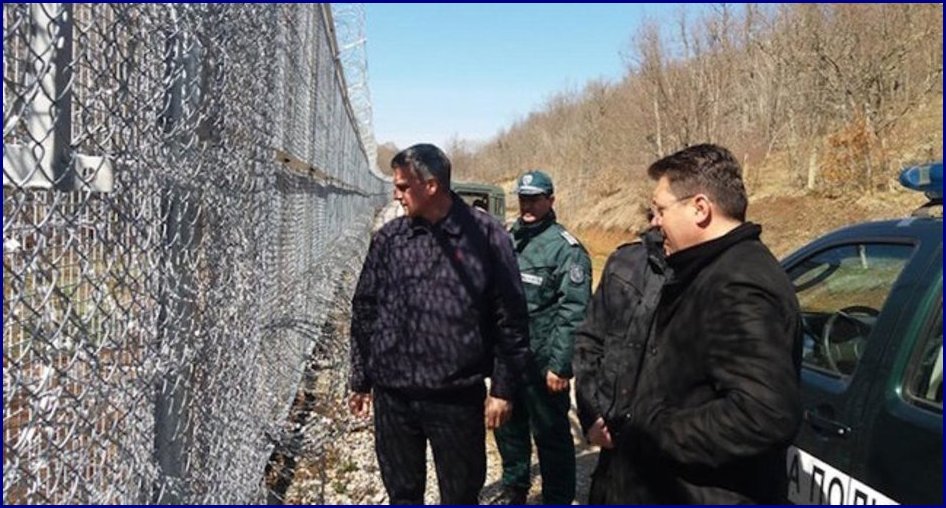
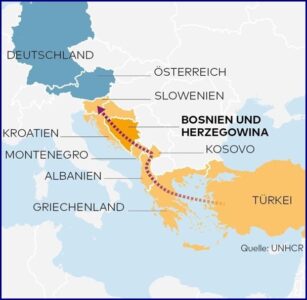 Recognizable because he also used this delaying tactic with Romania. A phone call to Brussels would have put him right out of the dream. Distressing for Bulgaria was the recent killing of three border officials who were doing their checks(external border) properly.
Recognizable because he also used this delaying tactic with Romania. A phone call to Brussels would have put him right out of the dream. Distressing for Bulgaria was the recent killing of three border officials who were doing their checks(external border) properly.
Visit Bulgaria’s 240 km external border with (European) Turkey and much will become clear. And the fact that one can cross the border with a 50-euro banknote in one’s passport is of a high drinks table level. Moreover, there is German/Bulgarian border surveillance.
Attorney General Ivan Gesbey: Bulgaria will ask for legal proof of Rutte’s allegations.
Austria
This country is going crazy and taking a run at the truth.
These claimed to have received an influx of asylum seekers who were not registered anywhere and were said to be largely from Bulgaria and Romania. However, it soon became apparent that after being checked by Frontex that these data were incorrect.
For the record: Frontex deploys hundreds of border and coast guard officers, along with ships, cars, planes and other equipment, to come to the aid of member states when they encounter problems at Europe’s external borders. These operations take place at European land and sea borders as well as in international airports. The map above shows the (Western) Balkan route followed by asylum seekers. A “leak” is at Serbia’s airport, among others, which do not require visas for asylum seekers coming from India, Tunisia, Burundi and Cuba. The reason being that they are countries that do not recognize Kosovo’s independence. And because it can reduce labor market tightness.
The Eurostat Database showed that a large proportion saw Austria as a transit country with destination Germany because the latter has a more humane policy.
However regardless of the numbers series, it quickly became apparent that Austria’s largest ruling party ÖVP was dropping in the polls ahead of the elections due in February 2023 and therefore playing the migration card. Meanwhile, they were shocked by the reactions in their own country because many felt it was an improper use of the veto because its theme was Schengen accession. Their coalition partner Grünen distanced themselves from this, as well as the country’s president (ceremonial position), people from the business community and the CEO of Erste Bank. Moreover, Romania has recalled its ambassador. There is no longer a willing ear in Brussels either.
Austria is therefore expected to withdraw its objection in the coming months.
Afterthought Editorial:
If one has followed the whole fuss about the Schengen discussion, one will quickly get the impression that the unanimity rule has been abused. Austria abused it, but also previously Hungary to block a large aid package for Ukraine. What is more egregious is that they were not opposing the aid, but blackmailing the European Commission to revoke its decision to freeze European funds for corruption in Budapest.To read more about how the veto and/or unanimity rule encourages rather than protects against the abuse of power click
here
Schengen, the praise of folly or the impotence of politicians?
The good news is that European member states have united against the actions of the Russian Federation, and the bad news is that some member states are behaving in such a way about Schengen that there are disagreements between some member states that threaten to weaken the position of European unity. Let us note that Schengen accession is independent of the war in Ukraine, but to some extent they are communicating vessels.
We limit ourselves in the following overview to a few main issues that largely define the picture. You as a reader may find yourself shaking your head wondering why politicians are giving themselves (and others) such a hard time.
Rutte’s dead sparrow
He recently made the statement that Romania could join Schengen. His initial doubt proved untenable because he was simply unaware of all the investigations that have taken place since 2011 under the (unofficial) Cooperation and Verification Mechanism (CVM). Not a good turn, in other words. But it got worse,  because he made it a condition that, according to his information, Bulgaria was not ready to join. And since the unanimity principle is in force, therefore Bulgaria as a member state will vote against it. Bad luck for Bulgaria and good luck for Romania you will suppose. After all, each country will be judged on its merits anyway, as it happened with Croatia. But by some strange quirk of thought both countries seem to be seen as a form of a federation and everyone knows that there has never been a coupling of the two states. Logical because it is at odds with the fact that each acceding country should be judged on its own merits.
because he made it a condition that, according to his information, Bulgaria was not ready to join. And since the unanimity principle is in force, therefore Bulgaria as a member state will vote against it. Bad luck for Bulgaria and good luck for Romania you will suppose. After all, each country will be judged on its merits anyway, as it happened with Croatia. But by some strange quirk of thought both countries seem to be seen as a form of a federation and everyone knows that there has never been a coupling of the two states. Logical because it is at odds with the fact that each acceding country should be judged on its own merits.
And let’s not forget that if one demonstrably fulfills the conditions and there is a right and not a favor!
In almost all member states and also in the European Parliament and the European Commission there is a negative view on this Dutch ruling. So again not a good turn.
Bulgaria
We have examined the Prime Minister’s statements and have not been able to discover a single fact by which the country did not meet the conditions. Admittedly, he candidly admitted that he did not have all the information at his disposal and wanted to receive information about this first.

Recognizable because he also used this delaying tactic with Romania. A phone call to Brussels would have put him right out of his misery. Distressing for Bulgaria was that recently three border officials who were doing their checks(external border) properly were killed.
Pay a visit to Bulgaria’s 240 km external border with (European) Turkey and a lot will become clear. And that one can cross the border with a 50 Euro banknote in the passport is of a high drinks table level. Moreover, there is German/Bulgarian border control.
Attorney General Ivan Gesbey: Bulgaria will ask for legal proof of Rutte’s claims,
Austria
This country is getting out of hand and taking a run at the truth.
 These claimed to have received an influx of asylum seekers who were not registered anywhere and were said to be largely from Bulgaria and Romania. However, it soon became apparent that after being checked by Frontex that this data was not correct.
These claimed to have received an influx of asylum seekers who were not registered anywhere and were said to be largely from Bulgaria and Romania. However, it soon became apparent that after being checked by Frontex that this data was not correct.
For the record: Frontex deploys hundreds of border and coast guard officers, along with ships, cars, planes and other equipment, to come to the aid of member states when they encounter problems at Europe’s external borders. These operations take place at Europe’s land and sea borders as well as at international airports. The map above shows the (Western) Balkan route followed by asylum seekers. A “leak” is located at Serbia’s airport, among others, which do not require visas for asylum seekers coming from India, Tunisia, Burundi and Cuba. The reason being that these are countries that do not recognize Kosovo’s independence. And because it may ease the tightness in the labor market.
The Eurostat Database showed that a large proportion saw Austria as a transit country with destination Germany because the latter has a more humane policy.
However regardless of the figure series, it quickly became apparent that Austria’s largest ruling party ÖVP was dropping in the polls ahead of the elections due in February 2023 and therefore playing the migration card. Meanwhile, they were shocked by the reactions in their own country because many felt it was an improper use of the veto because its theme was Schengen accession. Their coalition partner Grünen distanced themselves from it, as well as the country’s president (ceremonial position), business people and the CEO of Erste Bank. Moreover, Romania recalled its ambassador. There is no longer a willing ear in Brussels either.
It is therefore expected that in the coming months Austria will withdraw its objection.
Afterthought Editorial:
If one has followed the whole fuss about the Schengen discussion one will quickly get the impression that the unanimity rule has been abused. Austria abused it, but also previously Hungary to block a large aid package for Ukraine. What is more egregious is that they did not oppose the aid, but blackmailed the European Commission to revoke its decision to freeze European funds due to corruption in Budapest. To read more about how the veto and/or unanimity rule encourages abuse of power instead of protecting against it click
here
Disclaimer

The newsletter of the Dutch Romanian Network is compiled with great care. The Dutch Romanian Network cannot accept any liability for a possible inaccuracy and/or incompleteness of the information provided herein, nor can any rights be derived from the content of the newsletter. The articles do not necessarily reflect the opinion of the board.
